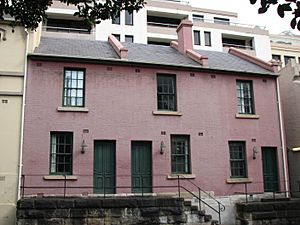61-65 Harrington Street, The Rocks facts for kids
Quick facts for kids 61-65 Harrington Street, The Rocks |
|
|---|---|

61-65 Harrington Street, The Rocks, New South Wales
|
|
| Location | 61-65 Harrington Street, The Rocks, City of Sydney, New South Wales, Australia |
| Built | 1870– |
| Owner | Property NSW |
| Official name: Terrace; Stafford Apartments; 75 Harrington Street; Clocktower Development. | |
| Type | State heritage (built) |
| Designated | 10 May 2002 |
| Reference no. | 1602 |
| Type | Terrace |
| Category | Residential buildings (private) |
| Lua error in Module:Location_map at line 420: attempt to index field 'wikibase' (a nil value). | |
61-65 Harrington Street, The Rocks is a special old building in The Rocks, a historic area in Sydney, Australia. It used to be a group of three homes, called a terrace, and is now used as serviced apartments. These apartments are known as the Stafford Apartments.
The building was constructed around 1870. It is considered very important because of its history and unique style. The Government of New South Wales owns the property through an agency called Property NSW. This building was added to the New South Wales State Heritage Register on 10 May 2002, which means it's protected and its history is valued.
Contents
The History of 61-65 Harrington Street
Early Days: Hospital Garden to First Homes
From 1788 to 1816, the land where 61-65 Harrington Street now stands was part of the first hospital garden in the colony. When the hospital moved in 1815, this land became available for building.
By 1822, there were already buildings on this spot. Maps from 1835 and around 1860 show an L-shaped building here. In 1845, records show a four-room stone house with a shingled roof that was in "bad repair."
New Owners and New Buildings
The land was given to William Young, who was recorded as the owner in 1851. Between 1851 and 1870, the site was sold several times. The old house was torn down between 1867 and 1871.
In 1871, the three two-storey brick terrace houses that we see today were built. They had slate roofs. Each house had a yard behind it with smaller buildings. The exact look of these smaller buildings isn't fully known.
Changing Numbers and Government Ownership
When they were first built, the houses at 61-65 Harrington Street were numbered 17-21 Harrington Street. In 1889, their numbers changed again to 23-27 Harrington Street.
In 1900, the Government of New South Wales took over the site and buildings. They continued to be rented out as homes until the 1970s. The current numbering, 61-65 Harrington Street, started in 1924.
Modern Development: Clocktower and Stafford Apartments
Today, these old terrace houses are part of a bigger project called the Clocktower development. This project was designed by Michael Dysart, Architects, and built between 1986 and 1989.
The Clocktower development includes 55 serviced apartments, 35 shops, office spaces, and a car park. The apartments in the old terrace houses are now known as the Stafford Apartments.
What 61-65 Harrington Street Looks Like
A Mid-Victorian Terrace Style
61-65 Harrington Street is a "mid-Victorian terrace." This means it's a row of three houses built around 1870, in a style popular during the middle part of Queen Victoria's reign.
The houses have two storeys and are built on a stone wall that raises them up from the road. The brickwork on the outside has been painted.
Unique Features and Materials
These houses look similar to others nearby, like 42-52 Harrington Street, which is almost directly across the road. They both have a special "flattened arch" design above the windows and doors.
The windows are mostly "twelve pane double hung" windows, which means they have two sashes that slide up and down, each with six small glass panes. The roof is steeply sloped and covered with corrugated iron. It was probably covered with slate originally.
Changes Over Time
- 1986/87: The front parts of the terrace houses were repaired and made to look new as part of the Clocktower development. The corrugated iron on the roofs was replaced with slate, which is thought to be the material used when the houses were first built.
There might be old things hidden under the floors that could tell us more about the building's history. This area is known as a "potential archaeological resource."
Why 61-65 Harrington Street is Important
State Heritage Significance
As of 2011, these terrace houses and their land are very important to the history and science of New South Wales. They are also important because they are part of The Rocks area, which is itself a very important heritage site.
Historical Value
The site has historical importance because it was part of the colony's hospital site in 1807. It also shows what housing was like in The Rocks during the 1800s.
Aesthetic Value
The terrace houses also look great and fit in well with other old buildings nearby. They are part of a strong visual group of buildings, including 55-59 & 67-71 Harrington Street, 42-52 Harrington Street, and the Harbour Rocks Hotel. They also connect visually to buildings on Argyle Street.
Archaeological Potential
There is a chance that old things are still buried under the floors of this site. These could be from the hospital garden or from later buildings. Studying these could help us learn more about the earliest European settlement in Australia. The Rocks is a sensitive area for archaeology, meaning there's a good chance to find historical clues from all periods of its development.

